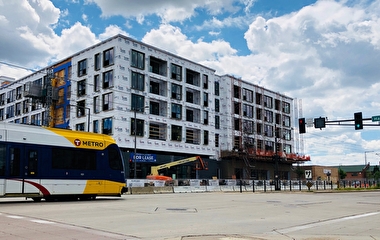With the aim of reducing congestion on the Twin Cities’ highly traveled I-35W corridor between the Minnesota River and I-94, the Minnesota Department of Transportation (MnDOT) began a major set of I-35W improvements in 2009 as part of the Federal Highway Administration’s Urban Partnership Agreement (UPA). Among the improvements was the addition of a priced dynamic shoulder lane (PDSL) on parts of the 17-mile stretch of highway; however, following the opening of these improvements, the frequency of rear-end crashes increased in certain sections—especially in the PDSL regions.
To untangle the underlying causes of this increase, MnDOT enlisted the help of researchers in the Department of Civil, Environmental, and Geo- Engineering. “Our primary objective was to determine if these increases were direct effects of the improvements or if they were due to changes in the traffic conditions,” says Professor Gary Davis, the principal investigator. “MnDOT was interested in extending some or all of these improvements to other corridors but needed to know what the safety impacts were to aid its decision making.”
Others on the research team included Jingru Gao, a master’s candidate advised by Davis, and John Hourdos, director of the U’s Minnesota Traffic Observatory.
The researchers began with a preliminary analysis to determine the study region and singled out two specific sections that were experiencing an increase in the rear-end crash frequency after the improvements. Next, these two sections were further divided, and data on crashes, traffic flows, weather conditions, and PDSL activation were compiled for each section. Researchers then analyzed the data to estimate the change in rear-end crash risk following the UPA project while controlling for traffic conditions, weather conditions, and PDSL activations.
The analysis resulted in several significant findings. First, researchers concluded that the operation of the PDSL had no direct effect on likelihood of rear-end crashes. In addition, they found evidence that crashes were most likely when lane occupancies were around 20 to 30 percent, and that crash likelihood tended to decrease for lane occupancies below and above this range. Finally, researchers concluded that the PDSL region experienced a substantial increase in congestion following the UPA improvements due to the removal of a bottleneck in the I-35W/Crosstown Commons; when controlling for this change in traffic conditions, there was no significant increase in rear-end crash risk attributable to the PDSL.
“The PDSL sections showed substantial increases in lane occupancy following the project,” says Davis. “The observed increases in rear-end crash frequency can be explained by increases in higher-risk traffic conditions, and the increase in higher-risk traffic conditions was most likely caused by the removal of the old Crosstown traffic bottleneck.”
“The research study showed us that the design of the PDSL did not increase crashes on this stretch of 35W,” says Brian Kary, MnDOT freeway operations engineer. “Had we not done the PDSL, congestion and ultimately crash rates would have been worse.”
In the future, the methodology demonstrated by this study could be used to evaluate the safety effects of other freeway-related projects because it worked out a way to estimate changes in hourly crash risk while controlling for variations in traffic conditions, Davis says. In addition, the finding that the current implementation of a PDSL did not have an adverse effect on safety can be used to provide guidance to MnDOT as it considers using PDSLs at other highway locations.





